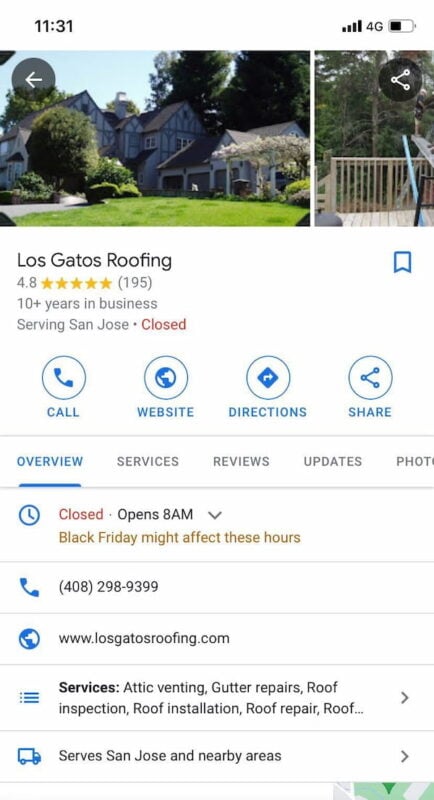Click Through Rate
There’s an endless discussion around Click Through Rate (CTR) as a ranking factor in organic search. The theory is that the more people click on your listing or website in a given search result, the more times it will show up for similar searches in the future. CTR is one step up from a branded search. CTR indicates, if not endorsement, that the searcher thinks the destination listing or website will be relevant to her query.
Google has never shared information about the inner workings of this ranking factor — and explicitly obfuscated its usage. But SEO practitioners suspect there’s a mechanism involving CTR relative to the position on the page. After all, the top results will always get the lion’s share of clicks.
You can improve your organic CTR with more compelling titles and meta descriptions on your web pages. Your Google Business Profile listings have fewer options, but a superior review profile — both star rating and volume — will help you stand out from the competition and earn more than your share of clicks.
Personalization
Much of the account infrastructure underlying Google’s products (Search, Gmail, Maps, YouTube, etc.) has been unified. As a result, we’re all perpetually logged in to the same account on every device. Some devices, like Android phones and Google Home, require users to log into their Google accounts before using them.
As a tracking and data-gathering platform, Google has been a smashing success. It’s now trivial for Google to track us from desktop to mobile to tablet, from Gmail to Maps to YouTube to Search, and back again. Our behavior in each product and on each device informs what we see in different effects on different devices.
At a strategic level, you should do everything you can to engage your customers with reasons to return to your website, engage with your email newsletter, and share your business with their friends and family via email and messaging. Google is probably monitoring all of those visits and shares. It may use them to inform future search results for those customers, friends, and family, even if they don’t convert on their initial visit.
Knowledge Panel interactions

As Google displays more and more Knowledge Panel results, the percentage of clickthroughs to webpages has dropped. But that doesn’t mean searchers are no longer clicking at all. Increasingly, clicks are happening within Knowledge Panels.
These Knowledge Panel click-throughs are far more substantial endorsements of a business’s relevance for a given query than a website visit. They’re a direct indication of a desire to transact with the company.
Phone calls
Google has offered mobile click-to-call functionality since January 2010. Even as early as February 2014, 40% of searchers had used it.
Driving directions
Where a phone call indicates a desire to learn more about a business, a request for driving directions is an even stronger indicator that a searcher intends to visit that business. The strongest of all purely digital signals that a business is relevant for a particular query.
Bookings (where available)
Google has long offered users the ability to make bookings with hotels and restaurants directly from the Knowledge Panel through partnerships with Expedia, OpenTable, and others. There are many other options, and businesses can now add their own booking buttons with the Maps Booking API feature.
By offering this in-SERP interactivity with a business directly through Knowledge Panels, Google reduces the number of clicks to business websites and can collect more data about how searchers view a business. However, this data influences rankings, as with most behavioral signals, only Google knows how much.
Comments
Post a Comment